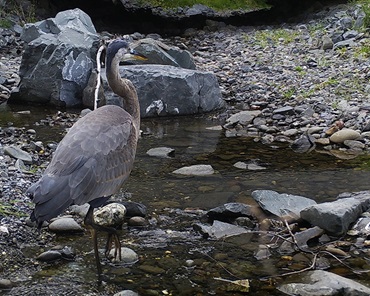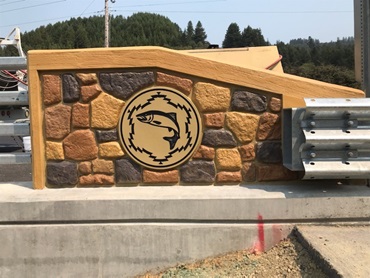In Humboldt County, new bridge gives wildlife safer passage

70-foot-long span near Orick makes Highway 101 less perilous for all
Caltrans recently completed a fish passage improvement project at Little Lost Man Creek along U.S. Highway 101 north of Orick in Humboldt County, which replaced an existing box-shaped culvert with a full-span, 70-foot-long bridge. The project reaffirms Caltrans’ commitment to environmental preservation and restoration as part of its stewardship of the state highway system, one of the tenets of the department’s 2020-2024 Strategic Plan.
Little Lost Man Creek is a tributary of Prairie Creek and flows through a lush, old-growth redwood forest with some of the tallest trees in the world and a vast array of plant species and abundant wildlife within Redwood National and State Parks. The U.S. 101 crossing of Little Lost Man Creek is about 450 feet upstream of its confluence with Prairie Creek. About three miles downstream, Prairie Creek drains into Redwood Creek, about six miles from the Pacific Ocean. The watershed lies within the ancestral lands of the Yurok Tribal People.
The Little Lost Man Creek Bridge, within the boundaries of Caltrans regional District 1, was built specifically to help area fish and wildlife make their life cycle journeys. Prior to the project, software modeling showed that adult fish were only able to pass through the old culvert under U.S. 101 only 5 percent of the time during passable flows, while the path for juvenile fish was completely blocked due to water velocity and water depth constraints.
The project area was eventually designated by Caltrans as a high-priority fish passage barrier. Project planners came up with a design that simulated the adjacent channel to restore the stream after the new bridge was constructed, and bio-stabilization techniques were used to protect the stream banks.

Project staff also minimized harm to fish by relocating them immediately prior to construction.
Revegetation included the addition of red alder, lady fern, cascara, cow parsnip, Douglas iris, sword fern, thimbleberry, salmonberry, Sitka willow, and red elderberry.
Caltrans initiated the Little Lost Man Creek project in 2016, drawing design plans and securing permits over the next several years before awarding a contract for the work in 2019. Construction was completed in 2020.
The improved passage now allows fish and amphibious species to access approximately 1.2 miles of upstream habitat, opening up more spawning territory for Chinook and coho salmon, and steelhead trout that travel between ocean and fresh water.
Although it’s called a fish passage, the project benefits more than just those species. The restored creek section underneath the new Little Lost Man Creek Bridge offers a more conducive travel corridor for species that include lamprey, frogs, salamanders, foxes, raccoons, river otters, fishers, martens, deer and black bears.
Other benefits also accrue from the project. Because the new passage allows for more consistent, natural flows, Caltrans’ Maintenance crews no longer have to clear piles of woody debris that built up at the old box culvert.
The project also provided Caltrans with an opportunity to partner with the Yurok Tribe, which was supportive during project planning.
District 1 has completed six fish passage projects in the last few years. Another seven passage projects are currently in the works, including two projects on U.S.199 that are scheduled to begin this summer.
Caltrans works to improve fish passages throughout the state by coordinating and partnering through Fish Passage Advisory Committees, which include staff from the California Department of Fish and Wildlife, the National Marine Fisheries Service and other remediation partners.
In 2020, the most recent year that statistics are available, Caltrans completed fish passage remediation projects at four barrier locations in the state, improving access to an estimated 124 miles of salmon and steelhead trout habitat. Caltrans is currently developing projects to remediate 28 fish passage barriers, which would improve access to 186 miles of currently blocked salmon and steelhead trout habitat.
The Little Lost Man Project was funded with $2 million from the Caltrans Bridge Rehabilitation and Replacement State Highway Operation and Protection Program (SHOPP) and received an additional $5.4 million in construction funding through Senate Bill 1.
Source: Myles Cochrane, Caltrans District 1 public information officer
Dominie Creek also outfitted with new fish passage

And another one! Caltrans also recently completed a fish passage improvement project at Dominie Creek along U.S. 101 in the Smith River area of Del Norte County. It replaced a box culvert with a full-span bridge, remediating a fish passage barrier, and providing unimpeded access for salmonids to approximately 1.6 miles of upstream habitat.
Additionally, 200 feet of concrete that lined the channel upstream was removed and replaced with streambed material embedded with willow stakes that will improve stream conditions by providing cover, shade, and food for the fish. Another 340 feet of stream channel was reconstructed to restore the channel below the bridge.
Caltrans, a contracted biologist, and the California Department of Fish and Wildlife worked together to relocate fish during construction activities. Species relocated include young-of-the-year trout, cutthroat trout, chinook, coastal giant salamanders, as well as red-legged and red-tailed frogs.
The design on the bridge abutments was created completely by a Tolowa Dee-ni’ Nation member as staff worked with the Federal Highway Administration (FHWA) to match it with the bridge’s color palette and nearby signage. This project served as mitigation related to Caltrans’ upcoming Dr. Fine Bridge Replacement on U.S. 101 near Smith River in Del Norte County.
Source: Myles Cochrane, Caltrans District 1 public information officer

